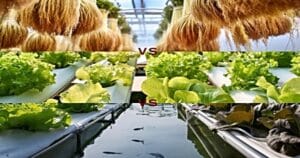 Aeroponics vs Hydroponics vs Aquaponics
Aeroponics vs Hydroponics vs Aquaponics
The quest for more efficient, sustainable, and productive farming methods in modern agriculture has led to significant advancements in soilless cultivation techniques.
Aeroponics, hydroponics, and aquaponics stand at the forefront of this agricultural revolution, each offering unique benefits and challenges.
This article delves into the intricacies of these three innovative farming methods, comparing their processes, advantages, and suitability for different growers.
Want a free family-first food planning guide?
Click here to instantly download this Complete Checklist PDF. No purchase necessary.
Understanding the Basics Of Aeroponics vs Hydroponics vs Aquaponics:
Aeroponics
Aeroponics is a method of growing plants in an air or mist environment without using soil or an aggregate medium.
Roots hang in the air and are periodically misted with a nutrient-rich solution.
This technique is known for its efficient use of water and nutrients and its ability to produce healthy, fast-growing plants.
Hydroponics
Hydroponics involves growing plants in a nutrient-rich water solution rather than soil.
This method allows for precise control over the nutrients that plants receive, often leading to faster growth rates and higher yields.
Various systems within hydroponics exist, including the nutrient film technique (NFT), deep water culture (DWC), and drip systems, each with its own set of benefits and requirements.
Aquaponics
Aquaponics combines hydroponics with aquaculture (raising fish) in a symbiotic environment.
In this system, fish waste supplies nutrients for the plants, while the plants help to filter and clean the water, which is then recirculated back to the fish tanks.
This creates a closed-loop system that mimics natural ecosystems and can produce both fish and vegetables.
Want a free 78 item prepper checklist?
Click here to instantly download this Complete Checklist PDF. No purchase necessary.
Key Components and Processes
Aeroponics
- System Design: Aeroponic systems typically consist of a frame or tower structure where plants are suspended with their roots exposed to the air.
- Nutrient Delivery: Roots are intermittently misted with a nutrient solution delivered through nozzles or sprayers.
- Environment Control: These systems require precise control of humidity, temperature, and nutrient concentrations to ensure optimal plant growth.
- Maintenance: Regular cleaning and monitoring of nozzles to prevent clogging is essential.
Hydroponics
- System Design: Hydroponic systems can vary widely, from simple setups with plants in containers to complex, automated systems with multiple levels and channels.
- Nutrient Delivery: Plants are placed in a nutrient solution or medium that retains moisture and nutrients. Common mediums include rock wool, clay pellets, and perlite.
- Water Management: Proper oxygenation and circulation of the nutrient solution are critical to prevent root rot and ensure plants receive adequate nutrients.
- Maintenance: Plant health requires monitoring pH levels, nutrient concentrations, and water quality regularly.
Aquaponics
- System Design: Aquaponic systems integrate fish tanks with hydroponic growing beds. The water from the fish tanks is pumped through the growing beds and back to the tanks.
- Nutrient Cycle: Fish waste provides a natural source of plant nutrients. Beneficial bacteria convert fish waste into nitrates, which plants can absorb.
- Water Management: Maintaining water quality for both fish and plants is crucial. This includes monitoring ammonia, nitrate, and pH levels.
- Maintenance: Key tasks include regularly feeding fish, checking water parameters, and ensuring the balance between fish and plant populations.
Aeroponics vs Hydroponics vs Aquaponics: Advantages and Disadvantages
↓ Hydroponics or Aeroponics?
Aeroponics
Advantages:
- Efficiency: Aeroponic systems use up to 90% less water than traditional soil-based methods and require fewer nutrients.
- Faster Growth: Plants can grow up to three times faster due to optimal nutrient uptake and oxygenation of roots.
- Space Utilization: Vertical aeroponic systems maximize space, making them ideal for urban farming and indoor setups.
Disadvantages:
- Complexity: Aeroponic systems require precise control and regular maintenance, which can be challenging for beginners.
- Cost: Initial setup costs can be high due to the need for specialized equipment and control systems.
- Vulnerability: Plants are highly dependent on continuous misting. Any failure in the system can lead to rapid plant stress and potential loss.
Hydroponics
Advantages:
- Control: Hydroponics offers precise control over nutrient delivery, leading to consistent, high-quality yields.
- Water Efficiency: These systems use significantly less water than traditional agriculture, as water is recirculated.
- No Soil Issues: Hydroponics eliminates soil-borne diseases and pests, reducing the need for pesticides.
Disadvantages:
- Dependency on Technology: Hydroponic systems rely on pumps, timers, and other equipment. Power outages or equipment failures can impact plant health.
- Initial Cost: Setting up a hydroponic system can be expensive, though high yields can offset costs over time.
- Monitoring: Monitoring water quality and nutrient levels is essential to prevent imbalances.
Aquaponics
Advantages:
- Sustainability: Aquaponics creates a closed-loop system that mimics natural ecosystems, making it highly sustainable.
- Dual Production: This method produces both plants and fish, offering a diverse range of food products.
- Natural Fertilization: Fish waste provides a continuous supply of plant nutrients, reducing the need for synthetic fertilizers.
Disadvantages:
- Complex Setup: Aquaponics systems are more complex to design and maintain, requiring knowledge of both hydroponics and aquaculture.
- Balancing Act: Maintaining the right balance between fish and plants is crucial for system stability and productivity.
- Initial Investment: The cost of setting up an aquaponics system can be high, though it can pay off with time and proper management.
Want a free 78 item prepper checklist?
Click here to instantly download this Complete Checklist PDF. No purchase necessary.
Suitability for Different Growers
Aeroponics
Aeroponics is well-suited for advanced growers and those looking to maximize space in urban or indoor environments.
Its high efficiency and rapid growth rates make it ideal for commercial operations where space and resource optimization are critical.
However, the need for precise control and maintenance may deter beginners or those with limited technical expertise.
Hydroponics
Hydroponics offers a versatile solution for many growers, from hobbyists to commercial farmers.
Its ability to produce consistent, high-quality yields makes it appealing to those looking for a reliable and scalable growing method.
While hydroponics does require regular monitoring and maintenance, its various system options allow growers to choose setups that match their skill levels and resources.
Aquaponics
Aquaponics is best suited for growers interested in sustainable and integrated farming systems.
It appeals to those who value ecological balance and wish to produce plants and fish.
Due to its complexity, aquaponics is more appropriate for experienced growers or those willing to invest time in learning the nuances of managing both plant and fish populations.
Aquaponics can greatly benefit community projects, educational institutions, and commercial operations with a focus on sustainability.
Real-World Applications and Success Stories
Aeroponics
Aeroponics has applications in various fields, from urban farming to space exploration.
Vertical farms in urban areas use aeroponic systems to grow fresh produce year-round, contributing to local food security and reducing the carbon footprint associated with food transportation.
NASA has also explored aeroponics for growing crops in space, as the method’s efficiency and minimal resource requirements are ideal for extraterrestrial environments.
Hydroponics
Hydroponics is widely used in commercial greenhouses and indoor farms.
Companies like Gotham Greens and BrightFarms have established large-scale hydroponic farms that supply fresh produce to urban markets.
These systems allow for precise control over growing conditions, resulting in high-quality, pesticide-free vegetables that can be harvested year-round.
Hydroponics is also popular among hobbyists and home gardeners who want to grow their own food in limited spaces.
Aquaponics
Aquaponics has gained traction in sustainable farming communities and educational programs.
Projects like the Milwaukee-based Growing Power and the Global Aquaponics Initiative demonstrate aquaponics’ potential to provide fresh, local food while promoting environmental stewardship.
Schools and universities use aquaponics systems as educational tools to teach students about biology, ecology, and sustainable agriculture.
On a commercial scale, companies like Nelson and Pade, Inc. offer turnkey aquaponics systems and training for aspiring aquaponics farmers.
Future Trends and Innovations
Aeroponics
The future of aeroponics looks promising, given advancements in automation and artificial intelligence.
Automated systems that monitor and adjust environmental conditions in real-time can enhance the efficiency and reliability of aeroponic farming.
AI and machine learning integration can lead to predictive maintenance and optimized nutrient delivery, improving plant health and yields.
As urban populations grow, the demand for vertical farming solutions like aeroponics is expected to rise.
Hydroponics
Innovations in LED lighting, nutrient solutions, and system design will benefit hydroponics.
Energy-efficient LED lights tailored to specific plant needs can reduce operational costs and improve growth rates.
Enhanced nutrient formulations and delivery systems will give plants optimal nutrition, resulting in higher yields and better quality.
Developing modular and scalable hydroponic systems will make it easier for growers to expand their operations and adapt to changing market demands.
Aquaponics
Aquaponics is poised for growth as interest in sustainable and integrated farming systems increases.
Innovations in water filtration and recirculation technology can improve system efficiency and reduce maintenance requirements.
IoT devices for monitoring water quality and fish health will help farmers maintain balanced ecosystems.
As awareness of environmental issues and sustainable food production grows, aquaponics will likely gain more support from policymakers and investors.
Conclusion
Aeroponics vs hydroponics vs aquaponics each offer unique solutions to the challenges of modern agriculture.
By eliminating the need for soil and optimizing resource use, these soilless farming methods provide sustainable and efficient ways to produce fresh, high-quality food.
As technology and knowledge advance, these innovative farming techniques will play an increasingly important role in feeding the world’s growing population.
Whether you are an urban farmer, a commercial grower, or a sustainability enthusiast, exploring the potential of aeroponics, hydroponics, and aquaponics can open new possibilities for a greener, more productive future.
Why Trust Skilled Survival…
Go here now to review a full breakdown of:
- Who We Are
- Our Credentials
- Our Mission
- & Product Recommendations…
Here are a few highlights of our teams credentials & certifications:
- Certified Member of a Mountain Search & Rescue Organization
- Plant Emergency & Safety Leader for a Major Food Manufacturer
- Member of the 10TH Mountain Division Hut Association
- Certifications: Avalanche 1, WFR, CPR
- Official Gear Tester for Numerous Outdoor Gear Companies
- Countless Multiday Backpacking trips into Remote Wilderness
- Bachelor’s Degree In Mechanical Engineering
- Bachelor’s Degree In Civil Engineering
- Bachelor’s Degree In Biomedical Engineering
“It takes 20 years to build a reputation and five minutes to ruin it.” – Warren Buffett
We’re fully aware that trust is NOT something you GET but is EARNED.
And we’ll continue to earn YOUR trust through our forthright and honest approach with each new Blog Post, Guide & Product we create…
Prepare, Adapt & Overcome,
The post Aeroponics vs Hydroponics vs Aquaponics: Soilless Farming appeared first on Skilled Survival.



 Aeroponics vs Hydroponics vs Aquaponics
Aeroponics vs Hydroponics vs Aquaponics




